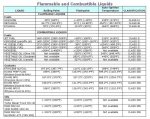Curtis told me that the Evans coolant caught on fire, which the tank is right behind the driver/firewall
Nobody thought that coolant can caught on fire, but there was a CO2 spray in the tank ... we have 3 fire saftey system on that car 2x CO2, 1x Water
I am very sorry to hear about Lynn's accident and I'm glad that the injuries are not very severe and that he is expected to fully recover from his burns.
It really saddens me, however, that no one thought that the coolant could catch fire.
Having personally been in a car that caught on fire when the exhaust pipe burned through a mis-routed heater hose, I know full well what can happen when engine coolant burns. Fortunately for me, I got out of the car before the fire could do serious bodily harm to me.
Engine coolants, including the typical ethylene glycol we are all familiar with as well as EVANS coolants are what OSHA classifies as COMBUSTIBLE LIQUIDS. In fact these coolants are CLASS IIIB liquids having a flashpoint above 200°F. If we look at the enclosed chart we will see that the "Flash-point" for these coolants is much lower than that for engine oil or transmission fluids, which I hope we all know they ARE combustible liquids.
"Combustible liquid" means any liquid having a flash-point at or above 100°F. (37.8°C.) -- Looking at the enclosed chart, we can see that EVANS coolants fall within that classification.
Below is some information about Flammable and Combustible Liquids that I put together for my company a while back. This information was obtained from manufacturers' MSDS information as well as various trade sources. I hope this information will help prevent another serious injury.
I've also included a PDF file that can be downloaded for future reference.
I hope you all find this information useful.
_____________________
Flammable and Combustible Liquids
Definitions:
Flash Point also flash·point (Flashpoint) n.
"Flashpoint" means the minimum temperature at which a liquid gives off vapor within a test vessel in sufficient concentration to form an ignitable mixture with air near the surface of the liquid.
Auto-ignition Temperature - The Auto-ignition Temperature of a chemical is the lowest temperature at which a material will ignite without an external source of ignition.
Flammable Liquids
The U.S. Occupational Health and Safety Administration (OSHA) defines a flammable liquid as "any liquid having a flash point below 100°F. (37.8°C.), except any mixture having components with flash points of 100°F. (37.8°C.) or higher, the total of which make up 99 percent or more of the total volume of the mixture. Flammable liquids shall be known as Class I liquids."
Class I liquids are divided into three classes as follows:
Class IA shall include liquids having flashpoints below 73°F. (22.8°C.) and having a boiling point below 100°F. (37.8°C.).
Class IB shall include liquids having flashpoints below 73°F. (22.8°C.) and having a boiling point at or above 100°F. (37.8°C.).
Class IC shall include liquids having flashpoints at or above 73°F. (22.8°C.) and below 100°F. (37.8°C.).
Combustible Liquids
The U.S. Occupational Health and Safety Administration (OSHA) defines a combustible liquid as "any liquid having a flash point at or above 100°F (37.8°C), but below 200°F (93.3°C), except any mixture having components with flashpoints of 200°F (93.3°C), or higher, the total volume of which make up 99 percent or more of the total volume of the mixture."
"Combustible liquid" means any liquid having a flash-point at or above 100°F. (37.8°C.) Combustible liquids shall be divided into two classes as follows:
"Class II liquids" shall include those with flashpoints at or above 100°F. (37.8°C.) and below 140°F. (60°C.), except any mixture having components with flashpoints of 200°F. (93.3°C.) or higher, the volume of which make up 99 percent or more of the total volume of the mixture.
"Class III liquids" shall include those with flashpoints at or above 140°F. (60°C.) Class III liquids are subdivided into two subclasses:
"Class IIIA liquids" shall include those with flashpoints at or above 140°F. (60°C.) and below 200°F. (93.3°C.), except any mixture having components with flashpoints of 200°F. (93.3°C.), or higher, the total volume of which make up 99 percent or more of the total volume of the mixture.
"Class IIIB liquids" shall include those with flashpoints at or above 200°F. (93.3°C.).
When a combustible liquid is heated for use to within 30°F. (16.7°C.) of its flash-point, it shall be handled in accordance with the requirements for the next lower class of liquids.

See more information from OSHA HERE





